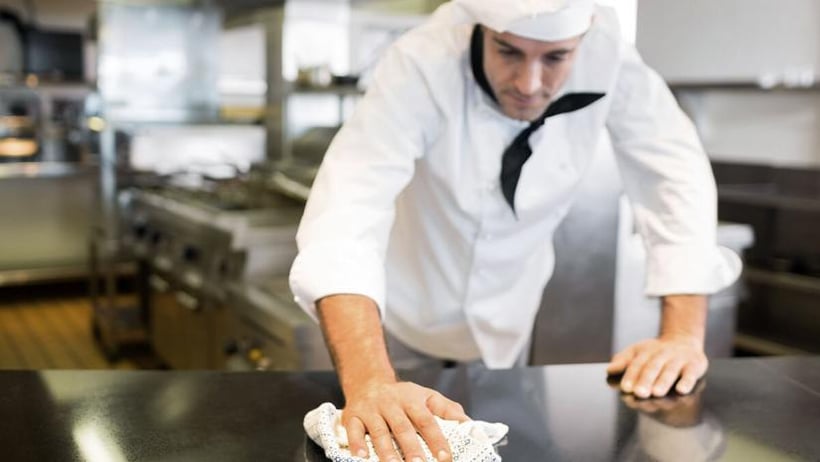
Cross-contamination can be a huge issue for food businesses caused by incorrect or inadequate cleaning and sanitizing procedures. Most kitchen staff know they must wash their hands thoroughly and frequently — but that’s only part of the overall picture when it comes to keeping customers safe and preventing a food-borne illness outbreak. Another crucial component is effective cleaning and sanitizing.
Before you even begin cleaning or sanitizing kitchen surfaces, evaluate the tools you’re using. A common misconception is that because sponges are soaked in various cleaning products most of the time, they must be clean. But in reality, sponges can harbour large amounts of dangerous microorganisms.
Sponges should be run through a hot washing machine cycle or periodically soaked in a bleach solution. They should also be regularly replaced — and don’t wait for them to look or smell dirty.
Dish towels are often magnets for germs, so you should use different towels for different tasks. For example, don’t dry your hands on the same towel you used to wipe a counter.
Every day, all kitchen surfaces should be wiped down with clean towels and strong cleaning agents, in order to kill organisms.
Cleaning versus sanitizing
They’re not the same — these two distinct processes require different tools and products, and have different purposes.
Cleaning removes all visible dirt, soil, chemical residues and allergens from equipment, utensils and work surfaces. Sanitizing, which is performed after cleaning, reduces the number of microorganisms to a safe level. If the surface isn’t first cleaned, sanitizing will be less effective.
All surfaces that come into contact with food must be cleaned and sanitized after every use — and this is especially true if you’re switching from working with raw and ready-to-eat foods. This could include dishware, glassware, cutlery, pots and pans, serving utensils, cooking equipment, as well as surfaces such as chopping boards, kitchen counters and tables where guests have dined. If an item is in constant use, it must be cleaned and sanitized at least once every four hours.
Items that have not had direct contact with food — such as chairs, floors, doors, walls and windows, under cushions, around light fixtures and curtains — must also be cleaned and sanitized regularly.
Maintain a cleaning and sanitizing schedule
In order to keep track of cleaning and sanitizing, create a Kitchen Equipment Cleaning Schedule that includes daily, weekly and monthly tasks, with a checklist that employees must complete as part of their duties. This schedule should include:
- detailed instructions on how all surfaces need to be cleaned
- how frequently each item must be cleaned
- who is responsible
- which cleaning agents to use (including concentration, temperature and contact time)
- how to avoid contaminating food
All staff should be trained in the proper cleaning and sanitizing process, and complete regular refresher training.
The 7-step process for cleaning and sanitizing
Print out the Canadian Institute of Food Safety’s (CIFS) 7 Steps to Effective Cleaning & Sanitizing Poster and post it in prominent locations in your food business to help ensure employees are following the correct cleaning and sanitizing procedure.
- Scrape: The goal of scraping is to remove all dirt, grease and food particles from the kitchen surface. Use a clean brush or cloth, and ensure all visible debris is gone before moving on to the next step.
- Rinse (first time): After scraps of dirt and food are gone from the surface, rinse with hot water — it should reach a temperature of 113°F (45°C) or above.
- Apply cleaning agent: Use hot water and a cleaning agent to remove any grease or food that still remains after scraping and rinsing. Follow the manufacturer’s instructions to use the correct amount, and thoroughly clean surfaces with small grooves or indentations, as bacteria can hide in these spots.
- Rinse (again): Rinse the item again with hot water, at a minimum temperature of 113°F, or 45°C. This step is important as it removes any detergent and reduces the risk of chemical contamination.
- Sanitize: When using sanitizer, always follow the manufacturer’s instructions to ensure the correct concentration and contact time. If you’re using a chemical sanitizer, be extra safe and test the solution with a test kit.
- Rinse (last time): A final rinse removes any remaining sanitizer or chemical agent that could potentially lead to cross-contamination of food.
- Dry: Always let items air dry as it’s more sanitary than using cloths or dish towels, which could potentially carry bacteria and actually undo your work.
Why are cleaning and sanitizing so important?
Cleaning and sanitizing helps to present a good image to customers. No one wants to eat in or purchase food from a place that’s unhygienic. And a good reputation boosts your business’s revenue.
Cleanliness also discourages infestations, as pests are attracted to scraps, crumbs, grease and other food residues. Food businesses are legally required to do everything possible to ensure a spotless, sanitary environment. Proper cleaning and sanitizing procedures provide the best defense against a possible food-borne illness outbreak.
All staff in your food business should be trained in and regularly implement effective cleaning and sanitizing procedures. CIFS’s Guide to Effective Cleaning & Sanitizing provides comprehensive tips for safe workplace cleaning and sanitizing practices, and our Food Handler Certification Course includes in-depth training on the proper ways to clean and sanitize, along with its impact on reducing food-borne illness outbreaks.




